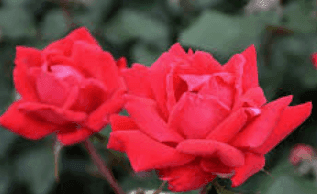Working With Roses Basics Introduction
Flowers, especially roses, are a great addition to any garden or room’s decor. The add color, fragrance, and elegance in what might be otherwise dingy spaces. Nothing can offer quite as much as a great floral arrangement, especially if those flowers are roses. Roses have always been a symbol of peace, love, friendship, and even death to all who see them. For centuries, roses have characterized great taste and eternity during events such as weddings, anniversaries, and birthdays. They are always the flower of choice when someone is hoping to create a bond with another.
Anyone can purchase roses in a gift shop or florist, but it takes a special person to want to grow their own roses. There are too many types of roses to list them all here, but this manual will be your beginners comprehensive guide to planting and caring for roses. By using this guide you will learn to:
• Plant roses
• Caring for roses
• Pruning roses properly
• How to fertilize roses
• How to water roses properly
• How to prevent rose diseases
• How to treat rose diseases
• How to revive sick roses
• How to help customers choose the best roses
That is a lot of stuff to learn by reading one simple manual, but this one has it all. By the time you have finished reading this, you will be prepared to take care of your customers roses. Since roses are such a high maintenance plants, there is a great deal that you need to learn.
At first glance, you may feel a bit overwhelmed by all of the things that you need to know before you can begin to plant them, but that will soon disappear after you read all of the easy to follow instructions mentioned in this guide. Get ready to learn all you can about roses. This will be the best thing that you ever did for yourself and your customer’s landscape.
Before we go through fertilizing and treating for rose diseases and insects, there is great news. Bayer produces a product called Bayer 3-in-one for roses. As a professional, this is the product we use on customers roses. It is a systemic product that includes fertilizer, disease control, and insect control. It will last for a year. This product is available at big box stores and Amazon so can be recommended to customers if your ornamental care program does not include roses.
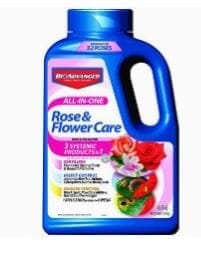
Choosing the Right Roses
The vast array of roses available for cultivation can make it overwhelming to choose the perfect one for your customers landscape. However, there are several important factors to consider when selecting the right rose, and here are some crucial pointers to guide you in your search.
1. Color: While seemingly trivial, color is often a key factor for those looking to grow roses. Personal preference plays a large role in this decision.
2. Height: It's important to take into consideration the final height of the rose as it could look unattractive if it grows taller than the surrounding flower bed. Some roses can reach upwards of 20 feet, while others tend to climb or ramble throughout the area.
3. Winter hardiness: For those living in colder regions, choosing a rose that can survive during the off season is essential.
4. Fragrance: If certain scents trigger allergic reactions, opting for roses with a softer fragrance may be ideal.
5. Advantages and disadvantages: Researching and understanding the pros and cons of different roses will help inform your decision.
6. Space limitations: Consider the size of the flower bed or landscape space to ensure proper exposure to air and other elements for a chosen rose.
7. Companionship: consider any other flowers or plants you plan on adding to the rose's environment, making sure they won't create a harmful ecosystem for a chosen rose.
Some Common Types of Roses
After you get a sense of the type of roses that you would like to suggest, you will naturally want to know which type of rose’s best fit your ideas for planting. There are too many to list here, but I can list some of them for you. You should consult your nearest garden center for advice on whether your choice of roses are fitting with the customers landscape limits.
Landscape Roses
Landscape roses are great for the novice gardener. They are disease resistant, and require a little bit less maintenance. Hybrid teas are not good for the novice.
Climbing Roses
These roses differ from the regular roses that are planted as they are trained to grow upward like vines. Most people like to use these for trellises, or buildings. Some of them are hybrid teas, wichuraianas, and large flowered climbers. They are a beautiful addition to the look of one’s house. Lady Banks variety is one of the most well known climbing roses.
Shrub Roses
Shrub roses like the beautiful rugosa are both long blooming, and disease resistant. These are also great for the novice planter. They are gorgeous even when they are not in bloom because the foliage is so pretty.
Old Garden Roses
These roses are not very good for those with severe allergies to strong fragrances because they have a strong fragrant odor. However, they are disease resistant and continue to bloom for months at a time.
The Modern Rose
These are very special roses because they result from cross breeding the hybrid tea with the polyanthus. They are also referred to as Floribunda. They beautifully combine the best those two flowers have to offer. They are long blooming, fragrant, and they are great for cutting.
Miniature Roses
Miniature roses are exactly what they sound like. They have all of the fragrance and beauty of a regular rose, but they have smaller blooms. These particular roses are great for indoor planting.
Planting Roses
The art of planting roses doesn’t have to be a complicated thing to do. When you have the right knowledge there is no limit to how beautiful a garden or rosebush that you can create.
In this guide, you will not only have all of the right skills at your fingertips, but you will get tips that you can use to grow a bed of roses. With this extensive manual at hand, you will never have to buy another bouquet again. Now you will have all of the beauty and delicious fragrance that roses can give you with you all the time. Here are some of the best ideas and tips for planting your customers’ roses.

Rose Planting
Gardening enthusiasts know that the art of planting roses can be a satisfying and rewarding experience. It's not as complicated as it may seem; all you need is some knowledge and preparation beforehand. Start by consulting your local gardening center or florist for advice on the best type of roses to grow in your specific climate. To avoid future issues, opt for disease-resistant varieties that require less maintenance and care.
When selecting the perfect spot for rose plants, keep in mind that they thrive in well-lit areas with at least 6 hours of sunlight per day. Choose a location with well-drained soil, ideally with a pH level between 5.5-7.0. You can check the acidity of the soil using a soil probe or by sending a sample to your local university plant soil sciences department.
Before planting, prepare the soil by adding organic matter such as manure or lime to nourish the roots of the roses. Soak the roots in water or puddle clay for several minutes and trim off any broken ends.
During the first 3-4 weeks after planting, make sure to water the roses frequently, as their roots are still establishing themselves. As a general rule, water when the top 2 inches of soil feel dry. After that initial period, water every 2 weeks for optimal hydration.
Around 3 months after planting, start fertilizing the roses and use 3-6 inches of mulch to regulate moisture and temperature levels while preventing weed growth. Mulch also helps keep essential nutrients that are vital for keeping growing roses healthy.
Spring is considered the ideal time for rooting and maintaining the health of rose plants, so plan accordingly when choosing when to plant.
Ensure proper air circulation around multiple roses by avoiding planting them in enclosed or tight spaces. A lack of airflow can lead to fungal diseases and hinder their growth.
When digging holes for planting, make them twice as wide as the space the roses will take up and grow into. This not only helps with planting but also allows them to grow freely without restricted circulation, which can lead to issues down the road. With these tips in mind, you'll be on your way to a flourishing rose garden that will bring beauty and joy for seasons to come.
Watering Roses
Watering roses can be a tricky thing. It is one of the most important aspects of taking care of them, just like other plants. Roses need almost as much water to stay healthy as people do. Of course there are quite a few things that must be considered before anyone waters their roses. Like people, roses need more water during the hotter weather than during the colder ones. Heat makes the soil dry faster and the roses get “thirstier”. Keep in mind that even during the rainier times, roses still need to be watered with fresh water because rain alone cannot provide the right amount of moisture for the roses. You want to water roses in a manner that goes deep enough into the surrounding soil so that it reaches the roots. Try going approximately 14 inches deep. You do not want to water the petals directly or the canes because it can cause fungal disease in roses. Make sure the customer doesn’t have an irrigation system that would apply the water overhead. Encourage drip lines or shrub nozzles on a micro-irrigation system. To help lower the risk of roses getting diseases, mulch is a great way to keep the soil moist, without allowing all of the fungal problems that too much moisture can cause. Watering roses in the morning also helps to dry the dew off of the leaves. Once the roses are fully established, they should be watered once a week. They should do it twice a week if it’s in the hotter months.
Fertilizing Roses
Fertilizing roses is a crucial step in ensuring their health and vibrancy. Just like humans, these delicate flowers require proper nourishment to thrive. Without the 26 essential nutrients, they may wilt and wither away.
To keep roses growing at a strong and steady pace, it's important to fertilize them regularly. This can be done using slow-release fertilizers such as fish emulsion or Osmocote, which should be applied according to the instructions on the label at the time of planting. Be careful not to over-fertilize during the winter months, as promoting recent growth at this time can make the plants more susceptible to freezing damage.
It's also important to pay attention to the condition of plants before fertilizing. Never apply fertilizer to plants that are experiencing heat or water stress, as this could lead to leaf and bud burn. In order for roses to absorb the maximum amount of nutrients, they should ideally experience consistent outside temperatures of 70-80 degrees Fahrenheit.
During the growing season, you can give roses a boost by applying a water-soluble fertilizer every two weeks. This will provide them with an extra dose of nourishment and help them flourish into beautiful, healthy blooms.
Pruning and Caring for Roses
Taking proper care of roses can seem like a very taxing, and time consuming thing to do, but the results of such care far more than make up for it. Unfortunately, roses are the most difficult flower to manage and keep healthy; however, all good things require high maintenance. There are many small things that have to be done to keep roses looking their best, but all of those small things add up to one very large one. Here are some great tips for the regular upkeep of roses.
1. You should prune roses in the early spring. Or at least once the others start budding because the buds will eventually become new branches later.
2. You should prune out the dead and damaged branches first. Next, you should cut all but five of the leftover healthy branches. They should end up at about the thickness of a pencil.
3. Cut the bushes by approximately one third or one half, depending on how tall you want them. Cutting above the outward facing buds, Which is the buds that is on the outside of the rose bush because this will help the bud to grow upward; which will make the center of the bud open up for better air circulation and shape.
4. You should always sharpen your hand shears before pruning, and prune the climbing roses with caution. The branches have a tendency to overlap and you wouldn’t want to prune
the wrong branches. It is also good practice to spray your cutting surfaces with 10% Clorox solution to keep from spreading disease.
5. Mulching is necessary because it helps to keep maintenance down. Mulching helps roses so that they need a lot less watering, weeding and helps prevent diseases. The best mulches are organic ones like wood chips, pine needles, and hulls. Rock mulch can collect heat and damage the roots, so it isn’t recommended.
6. Protect roses during the winter months by adding an extra inch or two of soil to the base of the roses. Don’t put the soil too close to the crown. This should provide the extra needed heat in the winter.
7. You should avoid the white plastic cones when doing your winter protection because they trap too much heat during the winter thaw. They are also quite unattractive.
8. You should feed roses water often, but lightly. When you water roses, avoid directly watering the foliage because it will cause fungal diseases. You should water the roses at the roots.
9. Keep the area around roses cleared to prevent them from getting locked in an area that doesn’t provide enough circulation.
Pruning Roses Basics
Pruning roses is one of the most needed and the most annoyingly difficult tasks that goes with proper rose care. It takes a steady hand the proper procedure to ensure the best
possible roses that you can help create. Pruning roses is basically the act of getting rid of dead and damaged pieces, and teaching the new growth to grow in the correct outward facing direction. That just means that you are training them to grow facing the outside of the shrub or bush. This gives roses the correct amount of circulating air to thrive in. Here are some proper techniques to guide you through the thought process of what and how to prune roses you are asked to care for:
Dip or spray your pruning shears in 10% bleach. This will help to prevent disease spread. Pruning in the early spring, just after the snow melts is best. You want to prune roses before any new growth appears. The best time would be when the buds are swelled, or red. Hand shears are the best tool for pruning the smaller branches. Loppers are best for the branches that are thicker or the thickness of a pencil or larger. If you are going to be working with a lot of roses, consider buying a pair of heavy rose gloves to protect again the thorns. You will want to get rid of the dead wood first. Next, you would want to take out any branches that are overlapping or rubbing each other. Leave the healthier branch and the one that will give you the preferred shape. You will want to make the roses fluted or vase shaped, with an open center, and keep them from touching or overlapping each other. Next, you want to get rid of the thinner weaker stems. Cut any healthy canes to be about one to four feet long, or whatever size that you prefer. Cut you roses properly so that they stay healthy. Cut so that the bud is facing outside of the bush and at a 45 degree angle that slopes inward so that you can keep promoting the outward growth. You should use bypass pruners that work like scissors and not the anvil types because the anvils crush the stems and make the roses more available to diseases.
Planting Potted Roses
It is common for people that have received roses in pots as gifts to fall so in love with their roses that they may want to replant them in their own garden. Adding a rose bush to any garden can be the best choice that you ever made. Planting potted roses doesn’t have to be a taxing experience. With the right knowledge given to you in simple step by step format can make the task a great deal of fun. Here are all of the steps that you will need in order to plant the container roses. You should plant contained roses in the spring, after you are absolutely positive that there is no chance for a return of the frost. If you live in a warmer climate like Florida or California, you will want to plant in the early autumn, once the weather has cooled off a bit. You will want to choose roses that do not have any flowers on them because you are simply trying to establish the roses. You are not trying to make the roses flower just yet. If you have to, trim the flowers off of them before you plant them. You definitely want to choose the right environment for the roses. You will want to plant them in an area of the garden that is susceptible to a lot of light in the morning, (at least 6 hours’ worth) because early morning light helps to dry the dew off of the flowers, which will help prevent fungal diseases. If you want the transition of roses from a pot to the landscape to go smoothly, you will need to prepare the soil very well. You want the soil to be well drained for the health of the rose plants. Once you have prepared all the soil, you will want to work several spadesful of compost into the planting hole after digging in a hole that is about two feet deep. Tap the rose from its original container and plant it. You will also want to position it so that the soil level of the rose matches the soil level of the surrounding soil. Last, you will want to dig a mote-like ring around the rose so that you can pool the water.
Growing Organic Roses
Many people are now getting into growing all things organic. Farmers are doing it with produce and meats, so it is natural that you might want to grow roses that way also. Many people have problems using the pesticides and insecticides that go along with growing roses and keeping them healthy. Well now you can use more natural methods of growing any roses. This section will show you how in a step by step method.
1. Each bush that you want to plant will need to have a foot of space all around it so that the flowers can get the proper amount of circulation. It also helps to prevent leaf diseases for roses.
2. You will want to purchase organic roses. You will want to buy roses that have a sturdy green stem and no blemishes on them. Bare root roses are best for this.
3. Along with roses that have green stems, you will need to look for stems that have evenly spaced leaves that are close together.
4. You will need to use well drained soil so that you can promote the healthy growth that will give the flower all of the water and nutrients that it needs from the root to the flower’s head.
5. Fix the soil so that you can build organically. You should use a raised bead if drainage is a constant problem. If needed, ask a local garden center rep about how best to fix the soil to be organically correct.
6. Soak all bare root roses in a large container of compost tea for many hours before you plant them.
7. You must mound up enough good organic sol that is mixed with an equal amount of compost in the middle so that you can spread the roots out and down from where they meet at the trunk.
8. Now, plant the rose at the point where the stem breaks into the root so that it is at soil level, or approximately 1 inch below the top level if you live in an area that is prone to hard winters.
9. You have to check bare root roses first. If the rose roots grow out in a tight circle, you have to cut a straight slice down each of its four sides. A knife is good for this. Then you will dig a hole that is 2 inches deeper than the container and at least twice as wide.
10. Mix organic soil garden soil with an equal amount of compost and use your hands to gently spread the roots into the soil mix.
11. You have to mulch to help you prevent roses from being exposed to weeds, and water stress complications. It will also ensure that roses remain at their lowest possible maintenance level.
12. You must feed roses organically also. Fertilize with organic fertilizer and maintain a regular watering schedule.
13. Water organic roses deep at the planting, and then once every week after that during growing season so that you can promote deep roots. Watering in the early morning is best.
14. You must cultivate the top inch of the soil around each rose and fertilize on a monthly basis with a balanced organic fertilizer. You will need a good granular type of fertilizer that you can work into the soil. Either that, or you or the customer can use a fish emulsion or seaweed based product that you can mix with water because it has all of the necessary nutrients that a healthy flower needs. Check the ingredients listed on the labels to ensure that they have nitrogen, phosphorus, potassium, iron and calcium.
15. To help protect the bed against the various types of pests and insects that can plague roses, put sticky yellow bars every ten feet to catch them.
16. You may use an organic pesticide if the problem is bad. Neem oil can be both an insecticide and a fungicide, so it is a common product to use on roses.
17. If the pest problem is severe enough, you may use insecticidal soap to spray on the roses.
Now you have all of the necessary knowledge that you need to service and advise customers with earth friendly roses. These roses will be just as beautiful as those that are not grown organically,
and will likely have the healthiest life span that a rose can get. Organic roses have especially vibrant color and stronger “immune systems”. The fragrance of organically grown roses can be more potent than roses fertilized with synthetic fertilizer. Of course, it still helps to know how to prevent roses from being taken over by diseases even if they may not be as susceptible. In the next section we will address preventing rose diseases.
Preventing Common Rose Diseases
Just like people, roses are susceptible to diseases and various other health problems. Many of the problems that come with having roses are relatively easy to take care of, but it is
always better to stop them all together rather than having to cure them later. Here are some ways that you can prevent diseases from reaching roses. The easiest way to prevent diseases from inhabiting roses is to buy roses that are low maintenance like shrubs and landscape roses. Planting roses properly in areas that have a lot of sun (at least 6 hours in the morning), air circulation and good compost for faster draining can prevent many problems later. Keeping different flowers and plants in with roses will help to provide the roses with a better and more balanced ecosystem to live in. Fertilize the plants in the proper manner. Roses need their food too! (see section on fertilizing for the best methods) . Watering roses correctly and in the morning is a good way to keep fungal diseases from hitting the roses. (see section on watering for the best techniques) . A two inch layer of mulch at the base of the roses is a good way to keep soil borne diseases at bay.
Rose rosette disease (RRD) is a plant virus that affects rose species and hybrids, including the Carefree rose series. It was first identified in the Rocky Mountains in the 1940s, and is widespread east of the Rockies. The disease is spread by eriophyid mites that are transmitted by grafting or feeding. Almost all roses are susceptible to the disease, and plants can die within just a couple of years. Symptoms include: Succulent, thickened stems, Witches' broom, flower distortion, discoloration, and excessive thorns. The only remedy is removing the infected roses to avoid spreading to nearby roses. Remove all parts of the rose, including the roots, and bag and dispose of them in the trash or burning them.
Fixing Diseased and Problem Roses
Even with the best of prevention techniques and caring for roses, you cannot always stop diseases and problems from affecting the roses. For all of the problems roses can encounter, there are just as many ways to fix them. All it takes is a little bit of tender loving care, and the right techniques. Here are some of those techniques to help roses look their best.
Aphids and Spider Mites
Aphids are a greenish brown insect that suck the juices from roses, and can eventually cause roses to dry out. To effectively treat them, simply blast roses with soapy water. Spider Mites are very tiny red mites. They suck the chlorophyll out of the cells of the leaves. When you are checking roses, place a white piece of paper under branches then shake the plant. Look to see what insects fall on the paper. Slightly run your fingers over the fall out and look for a streak. The streaks will be the remains of the spider mites.
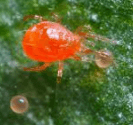
Spider Mite
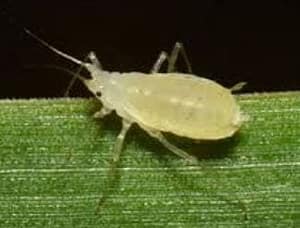
Aphid
Black Spot Black spot is a fungal disease that causes the canes to turn black or brown in spots on the foliage. To remedy this, simply prune the affected areas and throw out the clippings. Do not water overhead to prevent this from happening again. Removing infected leaves from the plant and fallen leaves from the ground will slow the spread of the infection, as does avoiding wetting the leaves of plants during watering. Fungicides, such as mancozeb, chlorothalonil, flutriafol, penconazole, or a copper-based product, applied upon new leaf emergence or first appearance of black spot, can be used to control the disease. If a more natural and nontoxic approach
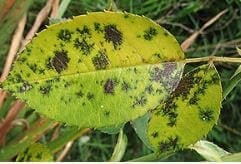
Canker
A canker is another fungal disease that causes the canes to turn black or brown. All you have to do is prune the canes just below the canker in the early spring.
Midge
A midge is a tiny maggot that causes the rose’s buds to blacken from the damage. If you want to fix this problem, prune the affected area and then destroy it.
Rust
Rust is a disease that creates an orange powder in the center of the rose. It is caused by wet and calm winter weather. Putting in some spider mites can help with this because they hate the water. You should consult your local garden center about the best insecticide to use in order to get rid of the spider mites if basic insecticide isn’t working. Using a combination of Imidacloprid and bifenthrin should keep them under control enough to get through the season. Once you have chosen the insecticide, spray every 7-10 days until it is under control.
Powdery Mildew
If you are trying to use organic solutions, you or your customer can put an end to powdery mildew by making a mixture of 1 gallon of water, 2 TBSP of baking soda , and 1 TBSP of Murphy’s Oil Soap . There are several fungicide sprays like Mancozeb Plus sulfur. Neem oil also helps with powdery mildew.
Have the homeowner spray over the roses in the morning every two weeks until the overall temperature around the roses reaches 80 degrees.
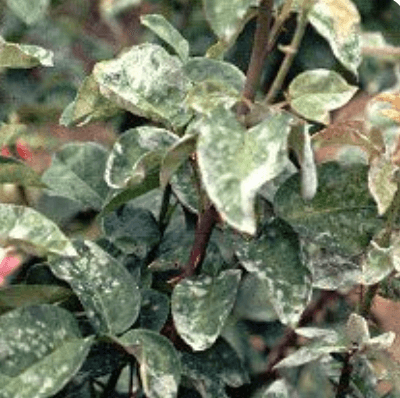
Powdery Mildew
Give Roses a Springtime Boost
Every spring people get energized and feel a new sense of Spring energy. It is like the very air in the spring time is rejuvenating in itself. Natural passions and new loves are often born in the spring, and old loves get a nice spark between them. Spring is definitely the best time of year to renew ourselves.
The same goes for roses. It is in the spring that people begin planting or replenishing their rose gardens. For those bushes that are already established, spring is the time to see new buds and blooms trying to be born. If you are interested in helping the roses get an even bigger boost in the spring, you may want to try this special tonic that is used to give the roses a strong boost of all of the nutrients that roses need in order for them to grow strong, healthy and produce a lot of buds. There are some key techniques that you will want to practice for the best Spring growth. Be certain to apply fertilizer in the early spring after you have removed any of the necessary winter protection. Here is a DIY mix recipe you can pass on to your customers or try it yourself.
A list of the ingredients that you will need to make this mixture follows. Wearing a dust mask, use a 5 gallon bucket to mix the ingredients in. 2 cups of alfalfa meal , 2 cups of Epsom salt, 2 cups of fish meal, 2 cups of gypsum, 2 cups of greensand, 1 cup of bone meal. You will first have to pull back the mulch that has been placed around any rose bush. You will next, want to work one cup of this fertilizer mixture into the top inch of soil if you have a smaller bush. Use 3 cups for large roses about 5-6 feet tall. Now you will need to replace the mulch and water the roses well. You can also add pre-emergent over the mulch to keep the area weed free for several months. Repeat in mid-June to keep roses flowering well. With this application you can just lightly mix the ingredients into the soil around the bases of the roses.
Cold Climate Roses
Most roses will grow just about anywhere, and in any type of climate. Certain roses do not function very well in cold climates, but will grow just as well in any other. Hybrid Teas are not however, a cold climate rose. They must be grown in a warmer climate like Florida. They simply don’t have the necessary winter protection that some cold climate flowers have. If you live in an area that is prone to harsh winters, you will likely find it relatively easy to find good, cold climate roses at your local garden center. It is necessary to plant cold climate roses in areas that are prone to winters because planting anything else would be a waste of your time as they couldn’t survive properly during the winter frost. Cold climate roses are great for many reasons. They are very low maintenance flowers, especially good for the novice. Cold climate roses also have their very own protection set up against diseases and bacteria that can plague any flower. Here a brief list of cold climate roses. Naturally, there are many more, but to list them all would make up the entirety of this guide.
The cold climate roses are as follows: Rugosas, Griffith Buck, Modern Roses, Centrifolias, Species Roses, Gallica, Alba, and Shrub Roses. These are just some of the cold climate roses that will thrive during the harsh winters of some localities. If you live in an area that is prone to harsh winters, you may want to see if your local garden center has any of these to start with.
Rose Care Summary
You have learned how to: Plant and take care of roses, How to help keep roses disease and problem free, How to grow roses organically, the best types of cold climate roses. Now, you should be ready to go out and talk to customers about their roses and begin preparing their soil for their new rose additions. Although there wasn’t a special section about mulching roses, the process was mentioned many times during this guide to roses. When you do lay down mulch in growing beds, you should be sure to enclose the area around it to prevent spillage. The mulch should be clean and be applied about 4 inches deep. If the roses have disease, the leaves that fall off should be removed so that the fungal spores don’t splash up on the new leaves. There are many ways that you can make a nice looking enclosure for a mulched area. At least place an edging around the beds like metal or curbing.

